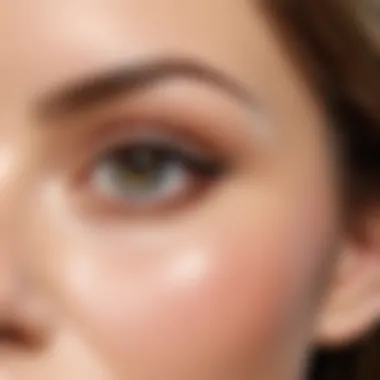A Comprehensive Guide to Hydroxy Acids: Types and Benefits


Intro
Hydroxy acids are pivotal in skincare, known for their transformative abilities. They are classified mainly into alpha-hydroxy acids (AHAs) and beta-hydroxy acids (BHAs). Each type serves unique functions and offers various benefits, making them essential in many cosmetic formulations.
As we delve into this guide, we will explore the diverse types of hydroxy acids, uncover their mechanisms of action, and discuss their practical applications. This article aims to equip both skincare enthusiasts and professionals with valuable insights, from selection to safe usage.
In addition, we will emphasize the importance of understanding potential side effects and the correct way to utilize hydroxy acids. By combining knowledge and best practices, readers will be better prepared to enhance their skincare routines.
Prologue to Hydroxy Acids
Hydroxy acids play a significant role in skincare, bridging the gap between cosmetic science and practical beauty applications. They are categorized based on their molecular structure and functionality. Understanding hydroxy acids is essential for anyone interested in skin health, as these compounds provide various benefits. Different types of hydroxy acids serve unique purposes, making them vital ingredients in many cosmetic products. This section unpacks the relevance and importance of hydroxy acids within the broader context of skincare routines.
Definition and Overview
Hydroxy acids are organic compounds characterized by the presence of one or more hydroxyl groups (-OH) attached to a carbon atom. This structural feature significantly influences their behavior and interaction with skin. Hydroxy acids can be divided into several categories, including alpha-hydroxy acids (AHAs), beta-hydroxy acids (BHAs), and poly-hydroxy acids (PHAs). Each of these acids has distinct properties and applications, catering to various skin types and concerns.
- Alpha-Hydroxy Acids (AHAs): These water-soluble acids primarily derive from fruits. They are known for their ability to exfoliate the skin surface, improve texture, and enhance radiance.
- Beta-Hydroxy Acids (BHAs): Unlike AHAs, BHAs are oil-soluble, making them effective for penetrating deeper into pores. They are particularly beneficial for oily and acne-prone skin.
- Poly-Hydroxy Acids (PHAs): These compounds offer similar benefits as AHAs but with a larger molecular structure, causing less irritation, making them ideal for sensitive skin types.
With a growing interest in skin health, the incorporation of hydroxy acids into daily skincare regimens has become increasingly popular. Despite their widespread use, choosing the right type for specific skin concerns is crucial, highlighting the need for informed decisions regarding their application.
Historical Context
The use of acids in skincare dates back centuries. Ancient cultures recognized the benefits of natural exfoliants. For example, Cleopatra reportedly used sour milk, rich in lactic acid, for its skin-enhancing properties. Over time, skincare science has evolved, advancing the understanding of how hydroxy acids function at a molecular level.
In the 1970s, the cosmetic industry saw a surge in the popularity of alpha-hydroxy acids, primarily due to their exfoliating properties. This was a pivotal moment, prompting extensive research into the various types of hydroxy acids and their effects on skin health. Clinical studies began demonstrating the benefits of AHAs in reducing sun damage and improving overall skin texture.
By the 1990s, beta-hydroxy acids, notably salicylic acid, gained attention as an effective treatment for acne, solidifying their place in both dermatology and cosmetic formulations.
Today, hydroxy acids remain at the forefront of skincare development, continually being refined and researched to optimize their benefits. Understanding the historical context of hydroxy acids provides insight into the evolving perceptions of skincare, showcasing their transition from home remedies to essential components of modern treatments.
"The importance of hydroxy acids in skincare is rooted in a rich history of natural practices that have informed modern formulations."
In summary, hydroxy acids are more than just trendy ingredients; they are rooted in history, underpinned by scientific research, and crucial for effective skincare.
Classification of Hydroxy Acids
Understanding the classification of hydroxy acids is essential for anyone interested in skincare. This section delves into types such as alpha-hydroxy acids, beta-hydroxy acids, and poly-hydroxy acids. Each category has distinct characteristics, making them suitable for various skin types and conditions.
Alpha-Hydroxy Acids
Common Types
Alpha-hydroxy acids (AHAs) are among the most utilized hydroxy acids. Some common types include glycolic acid and lactic acid. These acids are known for their exfoliating properties. They encourage the shedding of dead skin cells, thereby promoting a more radiant complexion. Glycolic acid is particularly well known for its small molecular size, allowing deeper penetration into the skin.
One key characteristic is their effectiveness in enhancing skin texture and hydration, making them a popular choice in various skincare products. However, they may cause sensitivity in certain individuals, requiring awareness before use.
Mechanism of Action
The mechanism of action of alpha-hydroxy acids lies in their ability to loosen the bonds between dead skin cells. This action facilitates better cell turnover and exposes newer skin layers. Because of this, AHAs are beneficial in treating uneven skin tone and fine lines.
Their effectiveness in exfoliation can also lead to improved absorption of additional skincare products. However, overuse may result in irritation, necessitating proper usage instructions to mitigate these risks.
Beta-Hydroxy Acids
Common Types


Beta-hydroxy acids, particularly salicylic acid, are notable for their oil-solubility. This property allows them to penetrate oily skin and clogged pores effectively. Salicylic acid is commonly used for its acne-fighting abilities.
The characteristic of being oil-soluble makes these acids particularly beneficial for oily and acne-prone skin. However, individuals with dry or sensitive skin might find it less suitable, possibly leading to further irritation.
Mechanism of Action
Beta-hydroxy acids primarily work by exfoliating the outer layer of skin and preventing clogged pores. The oil-soluble nature allows these acids to dissolve sebum and dead skin cells. This action is beneficial for treating existing acne and preventing future occurrences.
"The exfoliation from beta-hydroxy acids is different from AHAs, primarily due to their ability to penetrate oil, making them ideal for acne treatment."
Their unique mechanism of action helps balance oily skin types. Despite their benefits, overuse can still lead to irritation, making gradual introduction essential.
Poly-Hydroxy Acids
Common Types
Poly-hydroxy acids (PHAs) include gluconolactone and lactobionic acid. These acids are milder alternatives compared to AHAs and BHAs. They are often preferred for sensitive or reactive skin types.
One benefit of PHAs is their humectant properties, allowing them to hydrate the skin while exfoliating. The gentle nature of these acids makes them a favorable option for individuals new to chemical exfoliants or those who experience irritation with stronger acids.
Mechanism of Action
The mechanism of action for poly-hydroxy acids is similar to that of AHAs but with a gentler approach. They exfoliate by targeting the outer skin layers without penetrating deeply, making them safer for sensitive skin.
PHAs also hydrate the skin, making them a dual-purpose treatment. Despite their milder nature, it is still important to monitor skin reactions, as individual responses can vary.
Benefits of Hydroxy Acids
Understanding the benefits of hydroxy acids is fundamental to appreciating their role in skincare. These compounds serve several functions that go beyond mere beauty. From addressing skin concerns to improving skin texture and appearance, the significance of hydroxy acids cannot be overstated. This section will reveal why these acids are vital for anyone who seeks healthier and clearer skin.
Exfoliation
One of the primary benefits of hydroxy acids is their exfoliating property. They help in the removal of dead skin cells from the surface. This process is crucial because dead cells can lead to dull skin and contribute to clogged pores. For example, alpha-hydroxy acids, like glycolic acid, are widely recognized for their ability to promote cell turnover effectively. By sloughing off dead skin, hydroxy acids reveal a fresher and more radiant skin layer beneath.
Regular exfoliation leads to several positive outcomes. Cleaner pores minimize the chances of breakouts. Smoother skin enhances the application of makeup products, allowing for a more even finish. Additionally, skin texture improves over time, achieving a polished appearance.
Acne Treatment
Hydroxy acids offer significant benefits in the treatment of acne. Beta-hydroxy acids, notably salicylic acid, penetrate deep into the pores to dissolve debris and excess oil. This action is essential for preventing new acne formations. By reducing swelling and redness, they alleviate the visibility of existing breakouts.
Studies have shown that consistent use of salicylic acid can lead to a noticeable reduction in acne lesions over time. Moreover, it also assists in diminishing post-inflammatory pigmentation, which often lingers long after the acne itself has healed. Thus, those suffering from acne can find a reliable ally in hydroxy acids.
Skin Hydration
Although it may seem counterintuitive, hydroxy acids also aid in skin hydration. By removing dead skin cells, they help to increase the skin’s ability to absorb moisture. Notably, poly-hydroxy acids, such as lactobionic acid, can bind moisture to the skin, making it feel more hydrated and plump.
This aspect of hydroxy acids is particularly beneficial for those with dry or sensitive skin types. In addition to improving hydration, these acids can enhance the skin barrier function, leading to long-term benefits. As a result, the skin becomes more resilient to environmental stressors and less prone to irritation or dryness.
Anti-Aging Properties
Finally, hydroxy acids are renowned for their anti-aging capabilities. They stimulate collagen production, which is vital for maintaining skin elasticity and firmness. Alpha-hydroxy acids are particularly effective in diminishing the appearance of fine lines and wrinkles by promoting a smoother skin surface.
The cumulative effect of using hydroxy acids can lead to a noticeable reduction in age-related signs. Users may observe fewer lines and improved skin tone over time. As a result, incorporating hydroxy acids into a skincare routine can be a strategic move for those looking to maintain a youthful appearance.
In light of these advantages, incorporating hydroxy acids into everyday skincare practices emerges as a sound strategy for both prevention and treatment.
Selecting the Right Hydroxy Acid


Choosing the appropriate hydroxy acid is critical for optimizing skincare routines. Hydroxy acids can effectively address various skin concerns, but their effectiveness hinges on selecting the right type based on individual skin characteristics. Understanding the unique attributes of different skin types, as well as the formulation of products, is fundamental to achieving desired results. Incorporating the right hydroxy acid can lead to improved skin texture, tone, and overall health.
Skin Type Considerations
Oily Skin
Oily skin is characterized by excess sebum production, leading to a shiny appearance and enlarged pores. This skin type often experiences acne and blemishes due to the accumulation of dead skin cells and oils. For individuals with oily skin, beta-hydroxy acids, such as salicylic acid, are particularly beneficial. Salicylic acid can penetrate into the pores, helping to unclog them and reduce inflammation. Its ability to exfoliate at a deeper level makes it a popular choice among those needing a more thorough cleaning resolution for their skin issues. It also minimizes excess oil production, making it a suitable option in this article.
Dry Skin
Dry skin is often marked by flakiness, tightness, and irritation. Those who have this skin type may find alpha-hydroxy acids, like glycolic acid, more suitable. Glucolic acid works on the skin's surface to remove dead skin cells, promoting cell turnover and improving hydration levels. By enhancing the skin barrier, it can alleviate some dryness. However, users should take caution, as exfoliating too much can exacerbate dryness. Maintaining a balance is key, making users aware of their skin’s unique response to these acids.
Sensitive Skin
Sensitive skin typically reacts easily to products, showing signs of redness, itching, or irritation. For this skin type, poly-hydroxy acids are generally more favorable. These acids offer gentler exfoliation without causing irritation. Their larger molecular structure means they do not penetrate the skin as deeply as alpha- or beta-hydroxy acids, which can limit potential sensitivity reactions. Choosing gentle formulations can benefit those with sensitive skin, enabling them to enjoy the advantages of hydroxy acids without discomfort.
Product Formulations
Gels
Gels are light formulations that absorb readily into the skin. They work well for various skin types, especially oily skin, due to their non-greasy texture. Gels delivering hydroxy acids often provide quick results and feel refreshing when applied. However, some might find that gels with a high concentration of acids can be a bit too intense for sensitive types.
Lotions
Lotions offer a balance between moisture and active ingredient delivery, making them versatile. They are suitable for dry and normal skin types thanks to their hydrating qualities. However, those with oily skin might find them heavier. Choosing a lotion with hydroxy acids can enhance daily hydration while allowing for effective exfoliation.
Peels
Peels typically provide stronger concentrations of hydroxy acids and are intended for less frequent use. They offer significant benefits, including quicker exfoliation and improved skin texture. However, the intensity means that individuals must be cautious, as peels could irritate sensitive skin. Knowing when and how often to use peels is crucial for avoiding adverse effects. Their effectiveness can contribute tremendously to a refined skincare routine if utilized with care.
Incorporating Hydroxy Acids into Skincare Routines
In the landscape of skincare, understanding how to effectively incorporate hydroxy acids into daily routines is crucial for optimizing their benefits. Hydroxy acids, which include alpha-hydroxy acids (AHAs) and beta-hydroxy acids (BHAs), serve varied purposes, particularly in exfoliation and treatment of issues like acne and aging. Recognizing the importance of their use in skincare can empower individuals to achieve better outcomes, whether they seek brighter skin or improved texture.
Frequency of Use
The recommended frequency for using hydroxy acids can greatly influence their effectiveness. For gentle AHAs, a few times per week is often appropriate, especially for those new to these ingredients. An increase in frequency depends on individual skin tolerance and specific skin concerns. For oily or acne-prone skin types, BHAs can be used more frequently, sometimes daily. However, observing the skin's response is vital. If irritation occurs, it is advisable to decrease the frequency of application.
It’s essential to listen to your skin’s needs when incorporating hydroxy acids into your routine.
Layering with Other Ingredients
When adding hydroxy acids to a skincare routine, consider how they interact with other active ingredients. Proper layering enhances effectiveness and minimizes potential irritations.
Retinoids
Retinoids are well-known for their anti-aging qualities. Their inclusion in a skincare routine alongside hydroxy acids can yield significant benefits. Retinoids promote cell turnover, which complements the exfoliation achieved by hydroxy acids. Despite their advantages, users must be cautious as both retinoids and hydroxy acids can cause irritation when used together. Generally, it’s better to alternate their use, applying one at night and the other in the morning to mitigate potential negative reactions.
Vitamin
Vitamin C is celebrated for its brightening effects and antioxidant properties. When used with hydroxy acids, Vitamin C can bolster the overall radiance of the skin. However, timing is important. Hydroxy acids can lower the skin’s pH, which may affect the stability of Vitamin C formulations. Therefore, it is beneficial to use them at separate times or ensure that the skin's pH is balanced before applying Vitamin C.
Sunscreen
Incorporating sunscreen is critical when using hydroxy acids. Both AHAs and BHAs can increase skin sensitivity to the sun. Daily application of a broad-spectrum sunscreen helps protect the skin from UV damage. The key characteristic of sunscreen is its ability to prevent photoaging and hyperpigmentation, especially following thorough exfoliation. Thus, applying sunscreen should be non-negotiable in any skincare routine that utilizes hydroxy acids.
Potential Side Effects


Understanding the potential side effects of hydroxy acids is essential for anyone considering their use in skincare. While hydroxy acids are revered for their numerous benefits, it is equally important to recognize that they can sometimes lead to adverse reactions. This understanding aids users in making informed decisions about their skincare choices and ensures they can maximize the benefits while minimizing potential harm.
Common Reactions
Several common reactions may occur when using hydroxy acids. These can include:
- Redness and Irritation: Skin may become red or irritated, particularly with initial usage or if applied too frequently.
- Dryness and Peeling: Hydroxy acids exfoliate the skin, which can lead to dryness and flaking if the product is too strong or used excessively.
- Sun Sensitivity: Increased sun sensitivity is a frequent side effect. This is due to the removal of the outer layer of dead skin cells that provide some natural sun protection.
Individuals with sensitive skin types may experience heightened reactions. The degree of side effects can vary based on specific hydroxy acids utilized, their concentration, and the individual's skin sensitivity. By being aware of these common issues, users can better prepare themselves and monitor their skin's response to these acids.
Prevention and Mitigation
Preventing and mitigating the side effects of hydroxy acids involves careful management and consideration of usage patterns. Here are effective strategies:
- Start Slowly: Beginners should start with products containing lower concentrations of hydroxy acids. Gradually increasing usage can help the skin acclimate and reduce the chances of irritation.
- Hydration: Incorporating a moisturizer in the skincare regimen can help combat dryness and support skin barrier function.
- Sunscreen: Always apply a broad-spectrum sunscreen with at least SPF 30 during the daytime. This is crucial in protecting against the increased sun sensitivity brought on by hydroxy acid use.
- Alternative Products: If severe reactions occur, consider switching to milder formulations, such as poly-hydroxy acids, which may be gentler on sensitive skin.
It is vital for anyone using hydroxy acids to monitor how their skin reacts and adjust use accordingly. Consultation with a dermatologist is recommended if significant adverse reactions occur.
Regulatory and Safety Considerations
Regulatory oversight in skincare products, particularly those containing hydroxy acids, is vital for ensuring consumer safety and efficacy. Hydroxy acids, which are often used for their exfoliating properties, have seen a growing popularity in the skincare industry. Due to their potential impact on skin health, strict regulations are necessary to mitigate risks related to misuse or adverse effects. Understanding these regulations aids consumers in making informed choices and recognizing the significance of quality in skincare formulations.
FDA Regulations
In the United States, the Food and Drug Administration (FDA) plays a crucial role in regulating cosmetic products, including those containing hydroxy acids. While cosmetics do not require pre-market approval by the FDA, manufacturers are responsible for ensuring that their products are safe and properly labeled.
Hydroxy acids, particularly alpha-hydroxy acids (AHAs) and beta-hydroxy acids (BHAs), are scrutinized due to their ability to increase sun sensitivity of the skin. As a result, the FDA mandates that products containing these ingredients must include appropriate warnings and instructions for use. The concentrations of these acids in over-the-counter products are also monitored to prevent excessive exposure which can lead to irritation or chemical burns.
It is essential for consumers to familiarize themselves with these regulations. This knowledge can help them avoid products that may contain unsafe levels of hydroxy acids.
"Understanding the regulations behind skincare products is crucial for consumers aiming to maintain healthy skin."
Consumer Safety
Consumer safety is paramount when it comes to hydroxy acids and skincare. It involves not only the appropriate use of products but also awareness of potential risks associated with their application. Hydroxy acids can provide significant benefits, but irresponsible use may result in adverse reactions.
Individuals should consider several factors for safe use:
- Patch Testing: Before incorporating a new hydroxy acid product, performing a patch test can help identify potential allergic reactions.
- Start Slowly: It is advisable for users new to hydroxy acids to start with lower concentrations to assess skin tolerance.
- Sunscreen Usage: As hydroxy acids can increase skin’s sensitivity to sunlight, using sunscreen daily becomes crucial to protect the skin from UV damage.
- Ingredient Awareness: Being familiar with additional ingredients in a product can help avoid combinations that may cause irritation or reduce effectiveness.
In summary, the regulatory framework enforced by bodies like the FDA and the focus on consumer safety significantly influence the responsible use of hydroxy acids. It empowers individuals with the knowledge they need to safely navigate their skincare journeys.
Epilogue
The conclusion serves as a vital part of this guide, encapsulating the essence of hydroxy acids and their significance in skin care. Understanding the multifaceted nature of hydroxy acids—spanning alpha, beta, and poly-hydroxy acids—allows consumers to make informed choices. Hydroxy acids provide a variety of benefits, ranging from enhanced exfoliation to improved hydration and anti-aging properties.
As discussed in previous sections, knowing the right type of hydroxy acid is key to achieving desired skincare results. For instance, alpha-hydroxy acids can be effective for dry skin, while beta-hydroxy acids are often more suitable for oily or acne-prone skin. This guide emphasizes the importance of tailoring products to your individual needs, taking into account your skin type and concerns.
Moreover, adherence to guidelines on product use and application can reduce potential risks, enabling individuals to harness the full potency of hydroxy acids safely. As our skincare routines evolve, awareness of regulatory measures and safety considerations remains critical.
This reinforces not just the importance of hydroxy acids in modern skincare, but the need for continuous education on their properties and applications. The information provided in this article serves as a foundation for further exploration into skincare advancements and a starting point for informed discussions about future developments in the field.
Summary of Key Points
- Hydroxy acids are categorized into three main types: alpha, beta, and poly-hydroxy acids.
- Each type offers distinct benefits and mechanisms of action tailored to specific skin needs.
- Attention to skin type and product formulations is essential for effective use.
- Potential side effects can be mitigated through careful planning and application.
- Ongoing research is likely to reveal new uses for hydroxy acids in skincare.
Future of Hydroxy Acid Research
Research on hydroxy acids continues to evolve, revealing more about their effectiveness and applications. Future studies could focus on:
- New compounds: Exploring different hydroxy acids that may offer improved results or lesser known benefits.
- Combination therapies: Investigating the effects of hydroxy acids when used alongside other skincare ingredients like peptides or antioxidants.
- Long-term studies: Assessing the sustained benefits and potential drawbacks of prolonged use of hydroxy acids.
- Customization in skincare: Looking into personalized skincare solutions based on genetic or environmental factors.
It is evident that as knowledge deepens, so too will the practices surrounding the use of hydroxy acids, ensuring that they remain a cornerstone of effective skincare regimens.















